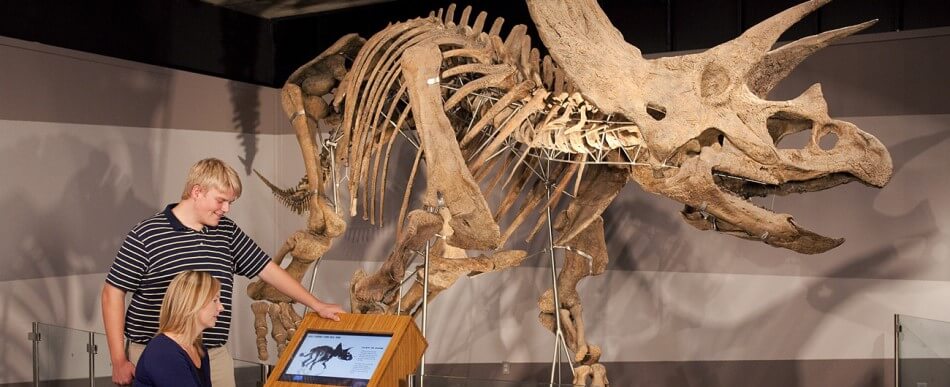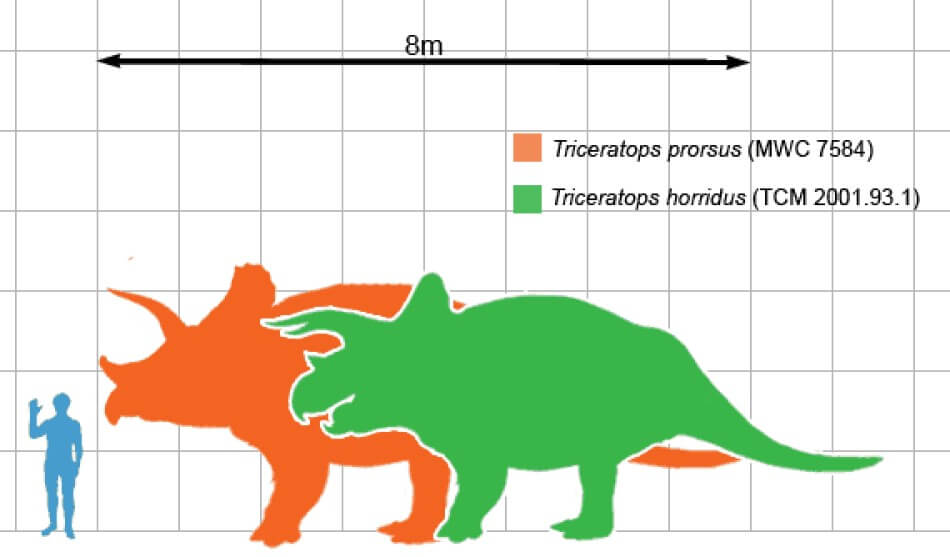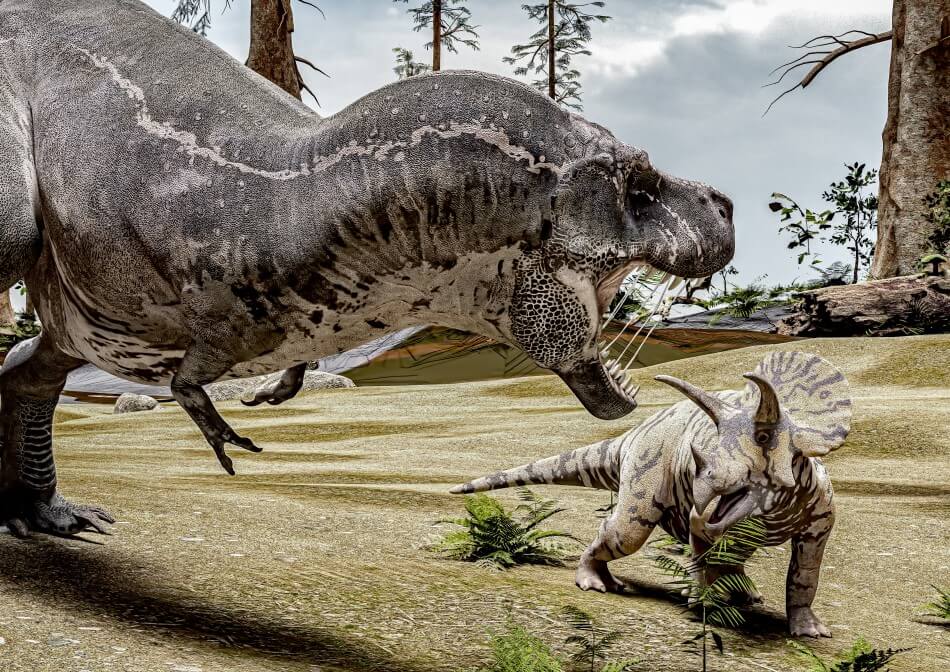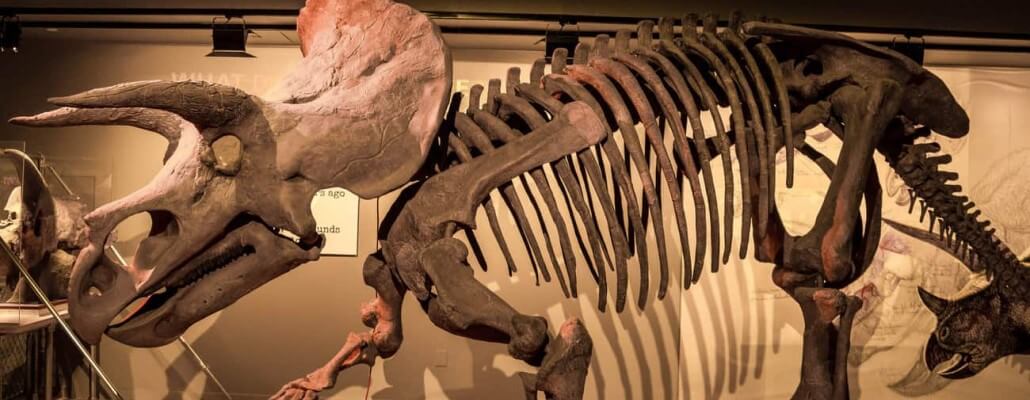The Triceratops has been a creature of fascination for many reasons, the standouts being, its enormous body, novel frill, and three horns. These dinosaurs walked the Earth in the late Cretaceous Period (around 65 million years ago) and were often pictured as travelling in large groups.
The Tyrannosaurs Rex occupied the same ecosystem as the Triceratops, which brings us to the question, did the T-Rex prey on Triceratops or did they live in harmony? The answer lies buried within these 19 Triceratops facts, read on to find out!
1. Known to be the last and largest of the horned dinosaurs, the name ‘Triceratops’ comes from the Greek language.
‘Tri’ means three and ‘keratops’ means horned face.
2. The first triceratops fossil was found by George Cannon, near Denver, Colorado, in 1887.
John Bell Hatcher then found the first full triceratops skull fossil in 1888.
3. Scientists have found Triceratops fossils in places such as Nebraska, Utah, Wyoming, Colorado, and Montana.
This gives us a rough idea of where they often resided, though the earth looked a lot different back then.
4. Triceratops lived and inhabited the marshes and forests of North America, around 65 million years ago in the late Cretaceous Period.
They lived up to the Cretaceous-Paleogene extinction event that wiped out the non-avian dinosaurs.
5. In the Boston Museum of Science one of the most famous triceratops specimens, ‘Cliff the Triceratops’, can be seen.
It’s named after the grandfather of the anonymous donor, and is one of the very few near complete triceratops skeletons on display.

6. The US state of Wyoming has listed the Triceratops as its state dinosaur since June 1994.
Other states that have a designated ‘state dinosaur’ include Colorado, with the stegosaurus, and New Jersey, with the hadrosaurus. There are 15 state dinosaurs in total.
7. The triceratops was squat and powerfully built, around the size of an elephant.
They had a short but powerful tail and walked on four thick legs weighing up to 11,000 kg (24,250 pounds) and could reach up to 9m (30 feet) in length and 3m (10 feet) in height.

8. Triceratops’s were slow-moving, quadrupedal reptiles.
This meant they walked on four legs, with shorter three-hooved forelimbs and longer four-hooved hind legs.
9. A Triceratops’ face was dominated by three horns and a huge frill.
The frill grew out from the back of its skull and covered its neck. Its mouth was beak-shaped and was best suited for grasping or plucking vegetation, rather than for biting. It most likely used its horns and strength to tip over taller and larger plants to acquire food, and for defence.
10. The largest known triceratops skull fossil is 2.5m.
This is around 8 feet, and has three distinct horns, a bony frill and a sharp pointed beak.
11. Triceratops were herbivores, eating mostly shrubs and other plant life such as ferns, cycads, and palms.
They had up to 800 teeth that were constantly being replenished and arranged in groups called batteries. The Evolution study notes show each battery had 36 to 40 tooth columns in each side of each jaw and three to five teeth per column.
12. The markings found on their beaks, jawline and teeth are evidence to their diet.
For example, thorny plants like cycad, characterised by a hard-wood trunk and stiff palm-like leaves, would likely leave these kinds of marks.
13. The way in which Triceratops had constantly replenishing teeth is very similar to sharks.
Triceratops had 800 teeth at its disposal, which allowed it to replace old worn teeth with sharp new ones.
14. Triceratops Horridus and Triceratops Prorsus are the two species of recognised Triceratops.
Another genus, Torosaurus (‘perforated lizard’) which had fenestrae (holes) in its frill, may have actually been a mature form of Triceratops. It has also been suggested that another genus, Nedoceratops (‘insufficient horned face’) may have been a transitional stage between the two.
15. Triceratops’ largest predator was the Tyrannosaurus Rex.
It used its skull to defend itself by goring the skin of predators and would generally stand its ground to face them, rather than run headlong into battle. Scientist believed that Triceratops and Tyrannosaurus Rex were involved in many long-standing battles against each other. We wonder which was the last dinosaur standing!

16. The T.Rex feeding on Triceratops was proven by a team led by Karen Chin.
They discovered a T. Rex coprolite (fossilised faeces) containing bones of the frill of a Triceratops in Canada!
17. It was once believed that Triceratops tromped through North American land in herds comparable to elephants.
However, triceratops may have also been solitary animals, as most fossils found have been of solitary individuals.
18. It is believed that triceratops had graveyards, termed “bone beds” where they gathered to die.
However, there is currently little evidence to back this up.
19. Palaeontologists have suggested that a Triceratops has a lifespan similar to that of mammals today.
Information on lifespan and age at death is obtained through skeletal remains and unfortunately for palaeontologists, the remains of Triceratops are not plentiful enough to obtain a reasonable sample for dating an average lifespan.
Triceratops Fact-file
| Type | Ceratopsian |
| Length | 9 metres |
| Weight | 5,500 kilograms |
| Diet | Herbivore (plant eater!) |
| Teeth | Beak with shearing teeth. Able to constantly grow new teeth and push worn teeth out. |
| Movement | Quadrupedal (walked on four legs) |
| Lived | Late Cretaceous period, around 68-66 million years ago |
| Found in | United States of America |
Triceratops FAQs
What are some fun facts about Triceratops?
The name ‘triceratops’ comes from the Greek language, where ‘Tri’ means three and ‘keratops’ means horned face.
Why did Triceratops have 3 horns?
It is believed Triceratops had 3 horns for a number of reasons. Firstly, they would have been useful for knocking down trees and other harsh shrubbery that they often fed on. Secondly, they acted as self-defence against would be predators such as the T-Rex. Finally, they may have been used as a visual display when it came to mating,
How long did the Triceratops live?
We don’t know for sure due to how hard it is to obtain information through fossils and skeletal remains. Palaeontologists believe they had similar lifespans to today’s mammals, such as the elephant, who can live up to 70 years.
Are Triceratops fast or slow?
Triceratops were small, squat dinosaurs, but were very powerfully built. Their legs were quite small compared to the longer legs of an elephant, but if they were able to gallop, it’s likely they could reach speeds of 15-20mph.
How many teeth did the Triceratops have?
Similar to sharks, Triceratops had a constantly replenishing supply of teeth. They could have up to 800 teeth, arranged into groups called batteries. Each battery had 36-40 tooth columns in each side of the jaw, with 3 to 5 teeth per column.
